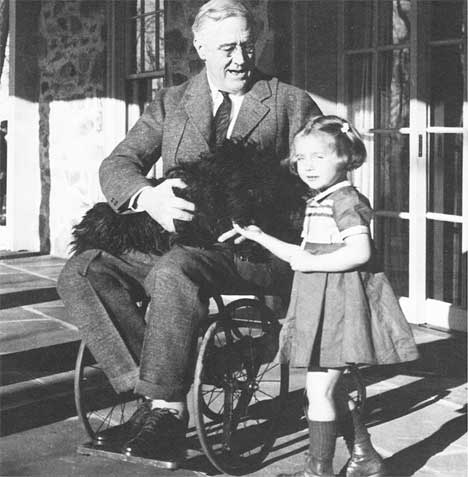Franklin Roosevelt Is Struck with Polio

One of the two pictures of FDR in Wheelchair
On August 10, 1921, Franklin went sailing with some of his children along the cost near their summer home in Campobello. On the way back they noticed a fire on the shore of an island. They landed and the family fought an exhausting and successful battle to put out the fire. They then stopped for a swim, and finally Franklin returned home exhausted. The next morning he awoke to find himself partially paralyzed. Two doctors misdiagnosed Roosevelts disease. The first said it was a common cold. Finally, on August 20, Franklin was diagnosed as having caught poliomyelitis or polio.
Franklin fought a hard battle to regain use of his body, which was paralyzed from the waist down. He worked constantly with his physical therapists trying to improve the use of his legs. He started using metal braces on his legs, which gave him a semblance of being able to stand on his own. During his attempted rehabilitation, Roosevelt discovered the therapeutic value of swimming, especially in warm water. As a result, he established the Georgia Warm Springs Foundation, around the warm water springs in Georgia in which he went to recuperate. Roosevelt devoted much of his time and effort to establishing the foundation.
Roosevelt initially kept the extent of the disease from the press. Early on in his illness, Roosevelt decided that it would not stop him from pursuing his political career. While he spent most of his time trying unsuccessfully to regain use of his legs, Roosevelt made sure that he maintained his political involvement through correspondence. In 1924, Roosevelt gave the nominating speech for Al Smith at the Democratic convention. The delegates greeted him with enthusiasm. His reception convinced him that his illness might not be a serious political liability. Throughout the rest of his political career, Roosevelt endeavored to limit the perception of him as a cripple. During his subsequent political campaigns, he was careful to present an image of an energetic and healthy campaigner. The press helped in these efforts by never publishing pictures of him in a wheel chair, or being carried by his aids. Roosevelt managed to overcome the limitations imposed by his disability with humor and perseverance.
 >
>